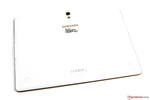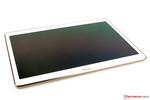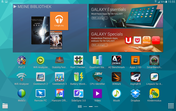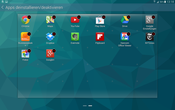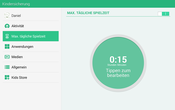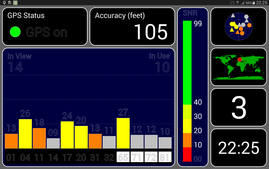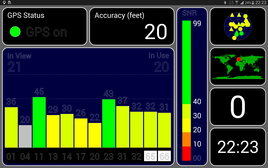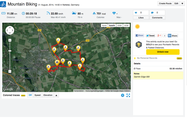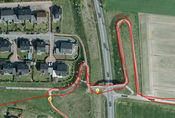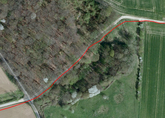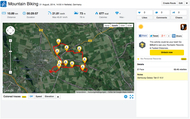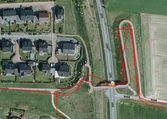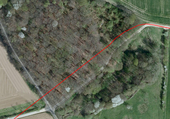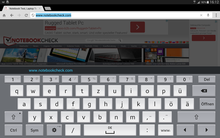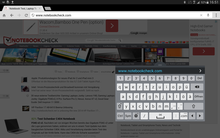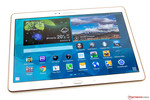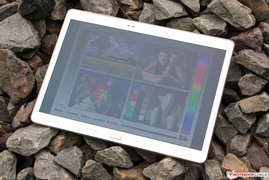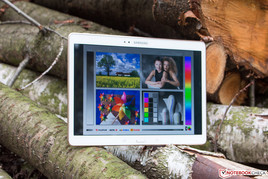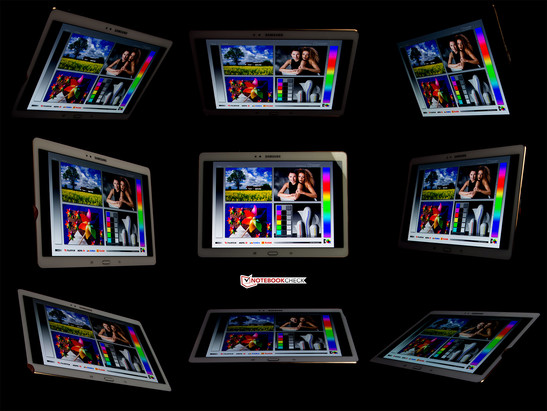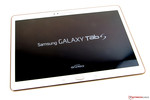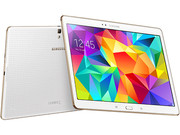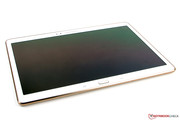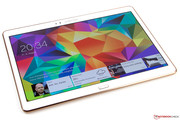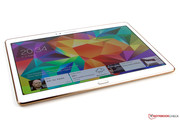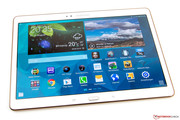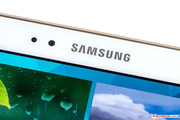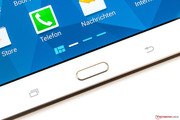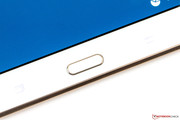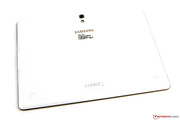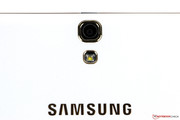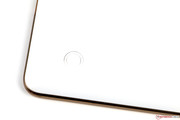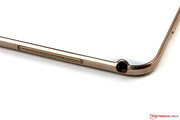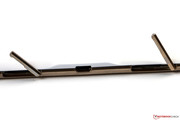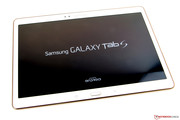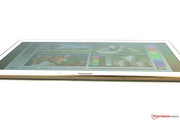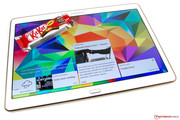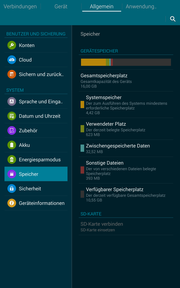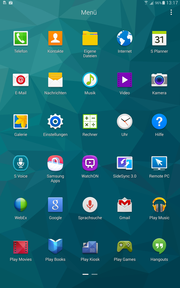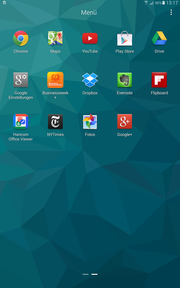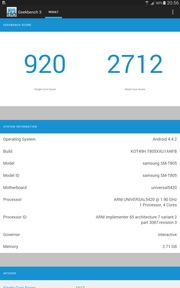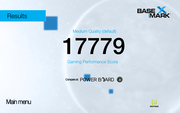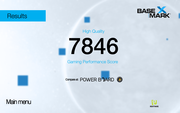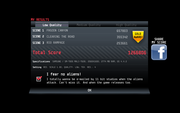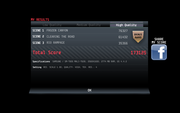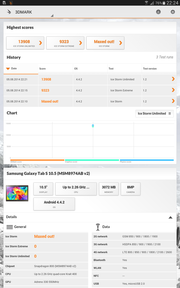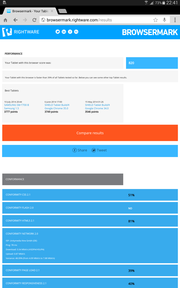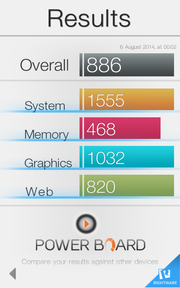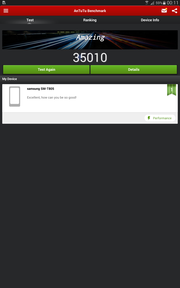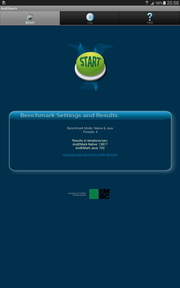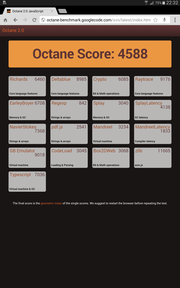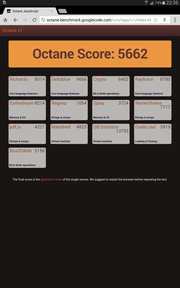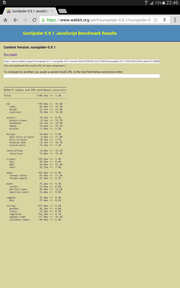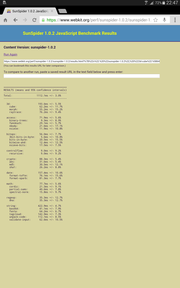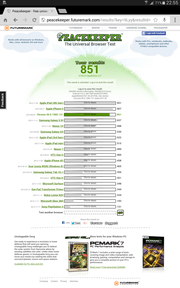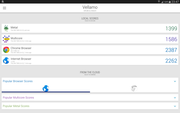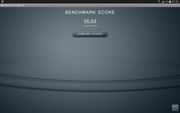Samsung Galaxy Tab S 10.5 Tablet Review

For the original German review, see here.
The Samsung Galaxy Tab S 10.5 is the first tablet, which has a Super-AMOLED display. The Galaxy Note 10.1 relies on a Super-Clear-LCD, which could convince in the test, but which still leaves room for improvements. The in-house competitor is equipped with a Snapdragon 800 SoC, while the manufacturer relies on an in-house development with eight processor cores for its most recent design. Otherwise, equipment of both tablets is relatively similar. For the Tab S 10.5 we are only missing an S-pen. Additionally, battery size is reduced, despite the somewhat larger display. Our test device is equipped with a 16 GB flash memory and LTE modem and can be purchased for 600 Euros (~$796) (RRP).
The competition is large and ranges from the Apple iPad Air (starting from 479 Euros; ~$636) to other Android tablets, such as the Sony Xperia Z2 Tablet (starting from 444 Euros; ~$589) or the Google Nexus 10 (starting from 399 Euros; ~$529) up to tablets with Windows 8.1 RT like the Surface 2 (starting from 429 Euros; ~$569) or the Nokia Lumia 2520 (starting from 525 Euros ; ~$697). Both for the Nexus 10 and the Surface 2 (Europe), no LTE versions are available.
The chassis of the Samsung Galaxy Tab S 10.5 is completely made of plastic. The back is reminiscent of the leather look of the Galaxy S5 with a pleasant touch and a good grip. Our white test device has a red-gold frame around the display, which feels very high quality, but which is also made of plastic. The tablet is also available in bronze. The panel itself and the frame are covered by a glass surface. Weighing just 470 grams (16.6 oz), the device is not too heavy and is only undercut by the iPad Air (467 g, 7.5 mm; ~16.5 oz, ~0.30 inches) and the Xperia Z2 Tablet (425 g, 6.2 mm; ~15.0 oz, ~0.24 inches). With a height of only 6.6 millimeters (~0.26 inches), it is extremely flat and lies comfortably in the hands. It is significantly slimmer than the Note 10.1 (535 g, 7.9 mm; ~18.9 oz, ~0.31 inches).
The Tab S 10.5 is insensitive to pressure. No undulations on the image occur from pressure on the back, the display frame or the touchscreen. The tablet is also relatively torsion-resistant, but creaks significantly. Clearances between gaps are very uniform and no point of criticism. Unfortunately, there is no IP certification as found with the Xperia Z2 tablet.
The battery is firmly fixed and not replaceable. Covers for the micro-SIM and memory card are tightly attached, but can be easily opened. The plastic is relatively insensitive to fingerprints. This is different from the glass cover, which in turn can be easily cleaned.
The Samsung Galaxy Tab S 10.5 has abundant equipment: the USB-2.0 interface supports OTG and is MHL-capable. DLNA and Ant+ are also supported. An NFC is not included. The infrared sensor is used through the app WatchON and can be used as universal remote control for Set-Top boxes, Media Player, DVD and Blu-ray player as well as television. Unlike the LG, the Tab S does not allow for control of an air conditioner or other appliances with similar receivers.
Both clip brackets on the back are reserved for optional accessories like a cover and integrates inconspicuously in the design. The memory card slot supports MicroSD cards up to 128 GB.
Software
Google Android 4.4.2 KitKat is used for the Samsung Galaxy Tab S 10.5. Besides, the manufacturer implements its own TouchWiz UI, which seems very structured and appealingly designed. Additionally, one can resort to Samsung's App store, which offers exclusive apps. SideSync 3.0 allows for synchronization of contents: text, links or other content can be copied to the tablet through copy-paste. The familiar child mode is also included, just like Multi Window, which enables parallel use of applications.
Unfortunately, there is also bloatware that cannot be uninstalled.
Communications & GPS
Among other things, the Samsung Galaxy Tab S can be connected to the Internet via a Wi-Fi mode, which is capable of the IEEE-802.11 standard a/b/g/n/ac. The wireless accepts both 2.4 and 5.0 GHz frequencies. The range is decent. Even at a distance of 20 meters (~66 feet) from the router (Fritz!Box6360), the tablet still showed half of the signal strength, where damping varies between -69 and -78 dBm in the 2.4 GHz frequency band. In the 5.0 GHz band, it was slightly weaker. Websites built up with a slight delay.
Our test device also has an LTE modem, which resorts to a large frequency coverage and which also supports HSPA+ up to a download speed of 42 MBit/s. With the fast data standard LTE, a download rate of up to 150 MBit/s and an upload rate of 50 MBit/s can be achieved. Additional speed can be obtained through the so-called Download Booster, which combines Wi-Fi performance with mobile data connection in order to speed up the download of media larger than 30 MB.
Samsung also chose to install a telephone app, such that it is possible to call from the Tab S 10.5. A telephone earpiece does not exist, so that only the speakers are available on the device itself. This should only be used in case of emergency since transmitted speech quality is only average. This could work better in combination with a Bluetooth headset.
The tablet supports Bluetooth in the version 4.0 with LE and A2DP, which makes it possible to stream stereo sound wirelessly in high quality to an external output device. That works without any flaws, just like the audio output of streamed Full HD web videos. Next to the data transfer, Bluetooth connection also allows for sharing the Internet connection of the tablet with another device (tethering).
Determination of the position is done via GPS, Glonass or the Chinese Baidu. In closed rooms, the satellite fix takes place within 13 seconds. Outdoor use only requires several moments. In order to judge the precision more thoroughly, we let the Samsung Galaxy Tab S 10.5 compete against the bike GPS computer Garmin Edge 500. Admittedly, the precision of that device is not achieved, since significant deviations in forested areas can especially be noted. On an entire route, these differences are only minimal, such that the performance of the components can be considered good.
Cameras
The Samsung Galaxy Tab S 10.5 has two cameras. The camera on the front is not only meant for video calls, but also for selfies. Admittedly, 2.1 MP (1920x1080 pixels, 16:9) do not necessarily suggest that, but the camera has a portrait mode, which uses a so-called airbrush effect. It is a simple blur, which is adjustable in five steps. Results are rather average and at most decent in good light conditions. But here again the relatively low resolution of the shots can be noted and when light is too strong, the image shows signs of overexposure.
The main camera on the back is much better. It has a resolution of 8 MP (3264x2448 pixels, 4:3) and delivers good quality by daylight. The colors seem very vivid and the image only appears blurred at the edges, where details become a bunch of pixels. For a tablet however, shots are good. In poor light conditions, quality decreases significantly and colors appear very pale. The Tab S 10.5 is one of the few devices within its class with an LED flash, which results in good images.
Many camera settings are possible. The various effects allow for interesting scenes. The panorama mode achieves even 360°. At this place, it would have been better to invest in more vertical pixels: just 960 pixels are rather poor. The HDR mode, however, works perfectly and allows for significantly better images in difficult light conditions.
Videos can be recorded in Full HD (1920x1080 pixels). UHD- or slow motion takes are not supported. Quality is decent in good light conditions. Here again, the microphone cannot convince since it is only mediocre.
Accessories
The delivered accessories of the Samsung Galaxy Tab S 10.5 include a short manual, a data cable and a modular power adaptor with a rated power of 10.6 Watts (5.3 Volts, 2 Amperes).
Optionally, the manufacturer offers a cover, which is available in different colors, but not in Europe. Besides, a Bluetooth keyboard should be soon available to buy, which also serves as a cover.
Warranty
Samsung offers a warranty of 24 months on its Galaxy Tab S 10.5, which cannot be extended. Accessories and battery have a warranty of six months.
Input Devices & Control
The capacitive touchscreen of the Samsung Galaxy Tab S 10.5 reacts very quickly to inputs. Sometimes one is not even sure whether the surface has been touched. Correspondingly, inputs are precisely translated and do not have to be repeated. Sliding properties are also good; a small unevenness on the surface can however be noted if one focuses on it.
The virtual keyboard is also well thought through and is suitable for typing. A nice feature is that it can be represented in a smaller version detached from the edge, in order to hide less of the content. Feedback can be given in the form of a sound or vibration. The pen input feature, as used for the Galaxy Note 10.1, is not available for the Tab S. Thus, a corresponding app is not preinstalled.
The fingerprint scanner is integrated in the home button. Up to three fingerprints can be stored by the system. Samsung keeps on ensuring that fingerprint data are only stored on the device. Once the feature is installed, only the fingerprint can unlock the tablet. In addition, payments via PayPal and the Samsung account can be done using a fingerprint. If the stored fingerprint happens to get lost, an alternative password ensures that the tablet can be accessed. The scanner itself works relatively well, even if the entire finger has to be pulled over the sensor. However, it happens quite often that we were too fast, or the finger was not correctly put on the input surface.
The Super-ALMOLED display of the Samsung Galaxy Tab S 10.5 is the highlight of the tablet. The 10.5-inch panel creates a Wow effect when looking at it for the first time. With 2560x1600 pixels it is no newcomer in terms of pixel dimensions, but it still has a very high resolution and delivers a pixel density of 288 ppi. With that, the test device has a higher pixel density than the iPad Air (264 ppi), despite the slightly larger screen. The Nexus 10 (300 ppi) has a similar resolution, but it is slightly smaller.
Brightness at pure white representation reaches a maximum value of 314 cd/m². That does not seem a lot, considering that similar competitors all show a higher value. The Lumia 2520 (max. 753 cd/m², 82%) has no rivals in this category. Using, however, the brightness sensor of the Tab S 10.5, a brightness of over 500 cd/m² can be achieved. Illumination with 87% is good, but not excellent. The Surface 2 (89%), the Xperia Z2 Tablet (89%) and the iPad Air (90%) are slightly better, but in practice such small differences are barely noticeable.
| |||||||||||||||||||||||||
Brightness Distribution: 87 %
Center on Battery: 290 cd/m²
Contrast: ∞:1 (Black: 0 cd/m²)
ΔE ColorChecker Calman: 2.37 | ∀{0.5-29.43 Ø4.78}
ΔE Greyscale Calman: 2.03 | ∀{0.09-98 Ø5}
100% AdobeRGB 1998 (Argyll 1.6.3 3D)
Gamma: 2.45
CCT: 6521 K
Due to the display technology, the black level of the Samsung Galaxy Tab S 10.5 is 0.00 cd/m², since an OLED panel does not depend on any background illumination. Contrast is therefore correspondingly high and tends towards infinity. Since none of the competitors has an AMOLED screen, all other screens perform worse. Black of the test device is deep black and colors are represented very intensively.
Therefore, most people perceive the color representation of an AMOLED display as over-saturated and unnatural. However, Samsung's engineers did everything right again. Calibration of the display at delivery is very good in all modes. Color deviations are neither visible in the sRGB nor in the larger Adobe-RGB color space. That is confirmed by the measurements of DisplayMate, which determined a complete coverage of both color spaces. With that, the tablet is also perfectly suited for professional use in the field of graphic design. This is a unique achievement, considering that even the iPad Air only covers the smaller sRGB color space.
The adaptive display adapts automatically to the represented content. Automatic can also be switched off. Then, the three profiles; Simple, Photo and Cinema are available. The first two barely show any deviation in the grayscales (dE 2) and the mixed colors (dE 2) and do not create any color cast. In Cinema mode (mixed colors dE 8), the high color saturation also leads to a higher deviation and a slight blue cast, which is indeed positive when watching a movie. Despite the OLED, color saturation is only slightly higher; for non-professionals no difference will be apparent. Only red is not perfect in terms of color fidelity, where it should be said that the measurements have been performed with the target color space sRGB. In the Adobe RGB color space, deviations are smaller (see also mixed colors). Overall, Samsung provides an excellent display.
Despite a glossy display surface, the Samsung Galaxy Tab S 10.5 performs well in outdoor use, where the tablet takes advantage of the extremely high contrast. Admittedly, strong sunlight is not easy to handle for the device, but just a few clouds are sufficient to obtain an excellent view on the panel, not to mention shady areas.
Viewing angle stability of the Samsung Galaxy Tab 10.5 is not bad either. The image remains stable in all positions and no color distortions show up, which is to be expected considering that the Tab 10.5 uses an AMOLED technology. From a viewing angle of 60° onward, a small loss in brightness can be noted, and from 120° on, a slight green cast appears. We could not discover a ghost-effect.
The in-house processor Samsung Exynos 5420 Octa is used for the Samsung Galaxy Tab S 10.5. Actually, the use of this SoC was already expected in the Note 10.1, but the manufacturer integrates a Snapdragon 800 for the European version. The Exynos 5420 has eight cores in total, which are composed of two quad-core processors. The first is based on the Cortex-A15 architecture and performs at up to 1.9 GHz and the second relies on the Cortex-A7 cores, which clock up to 1.3 GHz. For small loads, the more efficient A7 processor is used, whereas the A15 cores are used when more performance is required. The ample 3 GB internal memory supports the system. For graphics calculations, the integrated ARM Mali-T628 MP6 is used.
Performance is impressive, but is no longer part of the current high-end products. Application performance is however still very good and is on the level of a Snapdragon 800. Depending on how the many processor cores are used by the app, the Tab S 10.5 is sometimes faster than its competitors. Graphics performance is good, however, it cannot keep up with the current top systems. That is clearly visible in the 3DMark Ice Storm Unlimited Graphics Score (13,791 points), where all competitors are faster. In the GFXBench 2.7 (offscreen, 23 fps) it is somewhat more balanced. For the onscreen tests, the tablet has to pay the price for the very high resolution: frame rates are low.
| 3DMark | |
| 1280x720 offscreen Ice Storm Unlimited Score (sort by value) | |
| Samsung Galaxy Tab S 10.5 | |
| Microsoft Surface 2 | |
| Apple iPad Air 1 2013 | |
| Samsung Galaxy Note 10.1, 2014 Edition | |
| Nokia Lumia 2520 | |
| Sony Xperia Z2 Tablet | |
| 1280x720 offscreen Ice Storm Unlimited Graphics Score (sort by value) | |
| Samsung Galaxy Tab S 10.5 | |
| Microsoft Surface 2 | |
| Apple iPad Air 1 2013 | |
| Samsung Galaxy Note 10.1, 2014 Edition | |
| Nokia Lumia 2520 | |
| Sony Xperia Z2 Tablet | |
| 1280x720 offscreen Ice Storm Unlimited Physics (sort by value) | |
| Samsung Galaxy Tab S 10.5 | |
| Microsoft Surface 2 | |
| Apple iPad Air 1 2013 | |
| Samsung Galaxy Note 10.1, 2014 Edition | |
| Nokia Lumia 2520 | |
| Sony Xperia Z2 Tablet | |
| AnTuTu v4 - Total Score (sort by value) | |
| Samsung Galaxy Tab S 10.5 | |
| Samsung Galaxy Note 10.1, 2014 Edition | |
| Sony Xperia Z2 Tablet | |
| Geekbench 3 | |
| 32 Bit Single-Core Score (sort by value) | |
| Samsung Galaxy Tab S 10.5 | |
| Apple iPad Air 1 2013 | |
| Samsung Galaxy Note 10.1, 2014 Edition | |
| Sony Xperia Z2 Tablet | |
| 32 Bit Multi-Core Score (sort by value) | |
| Samsung Galaxy Tab S 10.5 | |
| Apple iPad Air 1 2013 | |
| Samsung Galaxy Note 10.1, 2014 Edition | |
| Sony Xperia Z2 Tablet | |
In terms of browser performance, the Samsung Galaxy Tab S 10.5 does not have to hide. Using the preinstalled Google Chrome browser (version 36), the tablet achieves good results in the benchmarks. Only in Sunspider 1.0 it somewhat trails its competitors. In practice, browsing is fast and in Multi Window mode, no speed losses show up as well.
| Peacekeeper - --- (sort by value) | |
| Samsung Galaxy Tab S 10.5 | |
| Nokia Lumia 2520 | |
| Google Nexus 10 | |
| Microsoft Surface 2 | |
| Samsung Galaxy Note 10.1, 2014 Edition | |
| Apple iPad Air 1 2013 | |
| Octane V2 - Total Score (sort by value) | |
| Samsung Galaxy Tab S 10.5 | |
| Nokia Lumia 2520 | |
| Microsoft Surface 2 | |
| Apple iPad Air 1 2013 | |
| Sunspider - 1.0 Total Score (sort by value) | |
| Samsung Galaxy Tab S 10.5 | |
| Nokia Lumia 2520 | |
| Microsoft Surface 2 | |
| Samsung Galaxy Note 10.1, 2014 Edition | |
| Apple iPad Air 1 2013 | |
| WebXPRT 2013 - Overall (sort by value) | |
| Samsung Galaxy Tab S 10.5 | |
| Nokia Lumia 2520 | |
| Microsoft Surface 2 | |
| Samsung Galaxy Note 10.1, 2014 Edition | |
| Apple iPad Air 1 2013 | |
* ... smaller is better
Memory of the Samsung Galaxy Tab S 10.5 is available in both 16 and 32 GB versions. Our test device is a 16 GB version. After startup, 10.6 GB are available for use. Since Samsung preinstalls quite a number of apps, additional space can be allocated by uninstalling unnecessary applications. Unfortunately, this is not possible for all apps. If more space is needed, it can be upgraded by up to 128 GB via a MicroSD card. Since the system also supports App2SD, apps can be transferred to the additional memory.
The performance of the memory is not very fast during linear reading and writing, but on the other hand, access speed for smaller data blocks is good.
Games
The integrated graphics unit ARM Mali-T628 MP6 allows for good gaming performance, even though it lacks some current high-class GPUs. Nevertheless, OpenGL ES 3.0 is also supported and it depicts graphically elaborate games like The Descent in high resolution. Racing games like Asphalt 8 are also no problem and together with the flawlessly working sensors, they ensure a perfect gaming experience. Only Anomaly 2 shows some stutters when the highest detail settings are chosen.
Temperature
The surface temperature of the Samsung Galaxy Tab S 10.5 is low and absolutely no point of concern. In idle mode, a maximum of 30.1° C (86.18 °F) is reached. The Note 10.1 (max. 33.3 °C; 92.3 °F) heats up more. The Microsoft Surface 2 (max. 28.3 °C; 82.94 °F) achieves the best value.
Under load, which was simulated with the Stability Test app, measured values climb up to 39.6 °C (103.28 °F). With that good value, the test device is mid-table. With 42.1 °C (107.78 °F), the iPad Air heats up the most, whereas the Surface 2 (max. 35.5 °C; 95.5°F) is again the coolest.
The temperature of the power adaptor also remains acceptable.
(+) The maximum temperature on the upper side is 39.6 °C / 103 F, compared to the average of 33.7 °C / 93 F, ranging from 20.7 to 53.2 °C for the class Tablet.
(+) The bottom heats up to a maximum of 36.4 °C / 98 F, compared to the average of 33.2 °C / 92 F
(+) In idle usage, the average temperature for the upper side is 28.8 °C / 84 F, compared to the device average of 30 °C / 86 F.
Speakers
Both stereo speakers of the Samsung Galaxy Tab 10.5 are well positioned. The quality of the output devices is however average. Basses for example, cannot be heard. Highs are clear and without any distortions, but seem slightly hollow at maximum volume. Other tablets like the iPad Air or the Dell Venue 11 Pro show how it could be better. Output via audio jack is relatively good, which is also confirmed by the RightMark Audio Analyser.
Energy Management
Power Consumption
Power consumption of the Samsung Galaxy Tab S 10.5 ranges between 2.1 and 3.9 Watts in idle mode. Its competitors partly exceed this range when the display is set to maximum brightness. The Nexus 10 needs here up to 9 Watts and the iPad Air (max. 7.1 W) also requires significantly more energy.
Under load, consumption of the test device climbs up to 10.4 Watts. Again, power consumption is relatively low. Only the Nexus 10 (max. 9.4 Watts), which has significantly lower performing hardware, and the Xperia Z2 Tablet (max. 7.4 W) need less energy. The power adaptor of the Tab S 10.5 is, however, relatively small-dimensioned with a rated power of 10.6 Watts.
| Off / Standby | |
| Idle | |
| Load |
|
Key:
min: | |
Battery Life
The Samsung Galaxy Tab S 10.5 has a 7900 mAh battery, which is thus smaller dimensioned than the one used for the Galaxy Note 10.1 (8220 mAh). This is mainly due to the flatter design, which does not offer enough space for a larger battery. Correspondingly, a lower battery life of the test device in comparison with the in-house competitor is bound to occur.
Maximum endurance of the battery is determined with an online script, which simulates the reading of a book. All loads are switched off and the display is dimmed. Since consumption at this lower panel illumination is higher than for other tablets, the test device cannot achieve a top score, where a determined value of over 18 hours is still very good. Conversely, activating all interfaces and setting the display illumination to maximum, results in 5.5 hours. In comparison to other tablets, that minimum battery life of the Tab S 10.5 is the best. The test was performed with the Stability Test app, which drains the battery as fast as possible.
The tests with adapted display brightness (150 cd/m²) provide a better comparison. In the test "browsing via Wi-Fi", a script is executed in the browser, which loads a website every 40 seconds. The test result of 10 hours is again a good outcome, which is only exceeded by the Lumia 2520 (13:23 h, 8120 mAh), the Nexus 10 (10:53 h, 9000 mAh) and the Galaxy Note 10.1 (18:25 h). The infinite playback loop of a Full HD movie results in 6.5 hours battery life. With that value, our test device comes in last. The other tested tablets achieve a battery life of over 10 hours.
Verdict
The Samsung Galaxy Tab S 10.5 is without any doubts an excellent piece of technology. Performance however, shows slight flaws. The Exynos Processor cannot entirely keep up with the current Qualcomm rockets. Graphics performance also falls slightly behind an Adreno 330. Nevertheless, the tablet performs decently in combination with Google Android 4.4 KitKat. Besides, memory can be upgraded and fast LTE ensures mobile Internet access.
The material choice is limited to a lot of plastic and some glass. Here, the test device is not on the same street as the iPad. On the other hand, the Tab S 10.5 is slimmer than Apple's star model. Yet, the Sony Xperia Z2 tablet can undercut this and is additionally insensitive to water and dust. The Galaxy Tab S does not have huge flaws: any possible complaints are on a high level. Only in terms of the speaker quality could the manufacturer have made a bigger effort.
In comparison with the Galaxy Note 10.1 we are missing an S-pen. This fact shows that Samsung wants to promote both products simultaneously. While the other model is more suited for a productive business use, the Tab S 10.5 is a slim multimedia performer, which truly inspires with a brilliant Super-AMOLED display.





